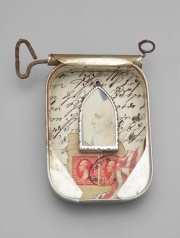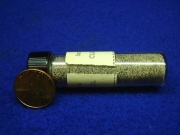Difference between revisions of "Tin"
JLBoutaine (talk | contribs) m |
|||
| Line 2: | Line 2: | ||
== Description == | == Description == | ||
| − | A soft, white metallic element. Tin occurs naturally as cassiterite, a tin oxide mineral. It has an abundance of 6 ppm in the earth's crust. The major producers are : China, Indonesia, Peru, Bolivia, Brazil, Congo (Kinshasa), | + | A soft, white metallic element. Tin occurs naturally as cassiterite, a tin oxide mineral. It has an abundance of 6 ppm in the earth's crust. The major producers are : China, Indonesia, Peru, Bolivia, Brazil, Congo (Kinshasa), Vietnam, Malaysia, Australia, Russia. Tin was produced for centuries in Cornwall by the Romans. It was (and still is) used as an ingredient in [[bronze]] casting alloys. [[Pewter]] is a tin (90%) alloy with [[copper]] and [[antimony]]. Tin alloyed with lead (75-90%) is called leaded tin. Both pure tin (also called bright tin and [[tinplate]]) and leaded tin were used in the U.S. in the 18th century as [[iron]] coatings in architectural construction (roofing pans, flashings, gutters) and for decorative items (trays, utensils, kitchenware, candlesticks, and boxes). From the 19th century, tin was used for cast toys and as a plating for iron toys. Tin quickly forms a passive oxide layer that resists pollutants and corrosion. However, any breaks or pits in the tin layer can cause severe deterioration due to galvanic action between the tin and iron. |
[[File:17.2173-SC24635.jpg|thumb|'''MFA Acc. #:''' 17.2173]] | [[File:17.2173-SC24635.jpg|thumb|'''MFA Acc. #:''' 17.2173]] | ||
| + | |||
== Synonyms and Related Terms == | == Synonyms and Related Terms == | ||
Revision as of 09:13, 30 October 2015
Description
A soft, white metallic element. Tin occurs naturally as cassiterite, a tin oxide mineral. It has an abundance of 6 ppm in the earth's crust. The major producers are : China, Indonesia, Peru, Bolivia, Brazil, Congo (Kinshasa), Vietnam, Malaysia, Australia, Russia. Tin was produced for centuries in Cornwall by the Romans. It was (and still is) used as an ingredient in Bronze casting alloys. Pewter is a tin (90%) alloy with Copper and Antimony. Tin alloyed with lead (75-90%) is called leaded tin. Both pure tin (also called bright tin and Tinplate) and leaded tin were used in the U.S. in the 18th century as Iron coatings in architectural construction (roofing pans, flashings, gutters) and for decorative items (trays, utensils, kitchenware, candlesticks, and boxes). From the 19th century, tin was used for cast toys and as a plating for iron toys. Tin quickly forms a passive oxide layer that resists pollutants and corrosion. However, any breaks or pits in the tin layer can cause severe deterioration due to galvanic action between the tin and iron.
Synonyms and Related Terms
Sn; stannum; étain (Fr.); Zinn (Deut.); stagno (It.); estanho (Port.); estaño (Esp.); tin (Ned.); Tenn (Sven.); straits tin (from Malaysia); tin flake; tin metal; tole
Other Properties
Resistant to organic acids. Insoluble in water. Dissolves slowly in dilute hydrochloric and nitric acids.
Cacotheline nitrate may be used for the colorimetric detection of tin in objects. Cacotheline reacts with tin to produce a dark purple residue.
| Composition | Sn (atomic no. 50) |
|---|---|
| CAS | 7440-31-5 |
| Melting Point | 231.9 |
| Density | 7.2984 |
| Molecular Weight | atomic wt = 118.710 |
| Boiling Point | 2206-2507 |
Hazards and Safety
Tin crumbles to dust at temperatures below 18 C (tin pest). Inorganic tin compounds can cause skin irritation. Organic tin compounds are toxic causing headaches, nausea, pain.
Mallinckrodt Baker: MSDS
Additional Information
° O. Untracht, Metal Techniques for Craftsmen, Doubleday and Co., Garden City, NY, 1968. ° J.Waite, "Architectural Metals: Their Deterioration and Stabilization" in Preservation and Conservation: Principles and Practice, S.Timmons (ed.), Preservation Press, Washington DC, 1976, p. 213. ° Web Elements: Website ° Ancient Trade Routes: Website
Authority
- Richard S. Lewis, Hawley's Condensed Chemical Dictionary, Van Nostrand Reinhold, New York, 10th ed., 1993
- The Merck Index, Martha Windholz (ed.), Merck Research Labs, Rahway NJ, 10th edition, 1983 Comment: entry 9587
- G.S.Brady, Materials Handbook, McGraw-Hill Book Co., New York, 1971 Comment: p. 809
- Dictionary of Building Preservation, Ward Bucher, ed., John Wiley & Sons, Inc., New York City, 1996
- Encyclopedia of Archaeology, Glyn E. Daniel, ed., Thomas Y. Crowell Co., New York, 1977
- David C. Scott, Metallography and Microstructure of Ancient and Historic Metals, The Getty Conservation Institute, Los Angeles, 1991
- Tom Rowland, Noel Riley, A-Z Guide to Cleaning, Conserving and Repairing Antiques, Constable and Co., Ltd., London, 1981
- Jack Odgen, Jewellery of the Ancient World, Rizzoli International Publications Inc., New York City, 1982
- A.Lucas, J.R.Harris, Ancient Egyptian Materials and Industries, Edward Arnold Publishers Ltd., London, 4th edition, 1962


